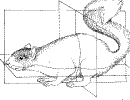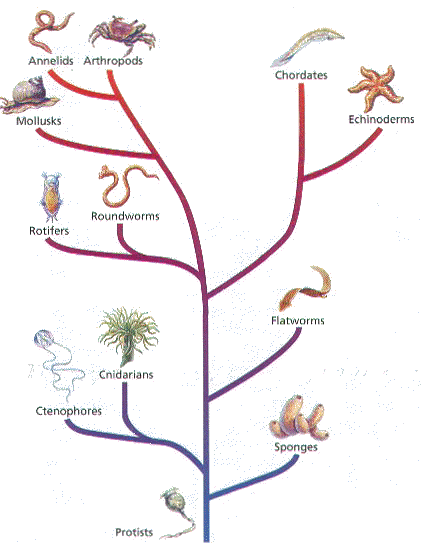
Image from: BIODIDAC
2.
This organism shows ___________ symmetry.
Asymmetry
radial symmetry
bilateral symmetery
Use
a paper and pencil to answer the questions.
You can check at the end to see if you are right .
1.
 Image from: BIODIDAC |
2.
This organism shows ___________ symmetry. Asymmetry
radial symmetry
bilateral symmetery |

|
#3. Acoelom
Pseudocoelom
Eucoelom |
Image from: http://www.lander.edu/rsfox/310images/310bil5.jpg
#4. Which body system deals with osmoregulation and getting rid of nitrogen waste made by body cells?

|
5.
This indented area seen in developing animal embryos is called the #6.
It will develop into the ________________ system. |
Image from: http://io.uwinnipeg.ca/~simmons/16cm05/1116/16anim3.htm :
#7.

|
#8.
Body parts (like a human arm and bird wing) which have the same
embryonic origin are called _________________ structures.
ANALOGOUS HOMOLOGOUS |
#9.
Which of the following is the correct way to write the scientific name for lion?
#10.
Which part of the name above tells its genus?
#11.
Nitrogen waste from body cells can be
#12.

Image
from htttp://sps.k12.ar.us/massengale/images/clip0075.jpg
|
#13.
This diagram used by the 6-Kingdom system which shows evolutionary
relationships based on multiple kinds of evidence is called a |
#14. Name the PHYLUM of invertebrates which is thought to be more like vertebrates than other invertebrates because of the way their embryos develop.
#15.
#16.
 |
#17. Organisms whose young hatch as an
immature larva, which undergoes
metamorphosis to change |
Image from: http://sps.k12.ar.us/massengale/introduction_to_animal_notes_b1.htm
#18.
Name 3 of the 6 Kingdoms used by Modern taxonomists to classify organisms.
#19. Name
3 kinds of evidence scientists might examine to classify a new organism.
#20.
Why is it advantageous for an animal to have a true coelom rather than no coelom
or a pseudocoelom?
#21.Name
one of the other systems used by scientists today to classify living things
besides the 6 Kingdom approach.
#22.
Name the levels of Linnaeus’s hierarchy in order from most to least inclusive.
#23.
#24.
#25.
#26.
#27.
#28.
#29. The concentration of nervous tissue and sensory organs in the anterior end of an animal is called __________________
ę
Image
from: http://bestanimations.com
|
#30. The arrow is pointing to the _____________ surface of this animal. anterior posterior ventral dorsal |
#31. From which of the three germ layers does muscle develop?
#32.
If you remove cells from or split the blastula in an early _____________
Protostome
Deuterostome
#33.
Maintaining the balance of water and ions in the body is called
__________________.
#34.
Write the genus and species name for humans using the correct scientific name.
#35.
The system of giving organisms a 2-part scientific Latin name is called
ANSWERS:
1.
deuterostomes
2. bilateral
3. "true" coelom OR eucoelom
4. excretory
5. blastopore
6. digestive
7. closed
8. homologous
9. Panthera leo
(1st name capital; 2nd lower
case; underline or italics)
10. Panthera (1st is genus; 2nd is species identifier)
11. Ammonia, urea OR uric acid
12. Carolus Linnaeus
13. phylogenetic tree
14. Echinoderms
15. Provides a space for internal organs
In animals w/o skeleton-acts as hydrostatic
skeleton
In animals w/ open circulatory system- provides
space for
nutrients and
oxygen to circulate
16. Cladistics
17. indirect
18. Archaebacteria, Eubacteria, Protista, Fungi, Plantae, Animalia
19. Fossil record
Morphology
Embryology
Chromosomes
Amino acid/DNA sequences
20. Able to move body muscles and digest at same time
21. Cladistics OR 3 Domain system
22. Kingdom
Phylum
Class
Order
Family
Genus
Species
23. Phylum becomes division
Subspecies becomes variety
24. Phylogeny
25. Echinoderms (starfish)
Any vertebrate (mammals, birds, fish,
reptiles, amphibians)
26. animal
27. invertebrates
28. endoderm, mesoderm, ectoderm
29. cephalization
30. dorsal
31. mesoderm
32. protostome
33. osmoregulation
34. Homo sapiens OR Homo sapiens
35. binomial nomenclature